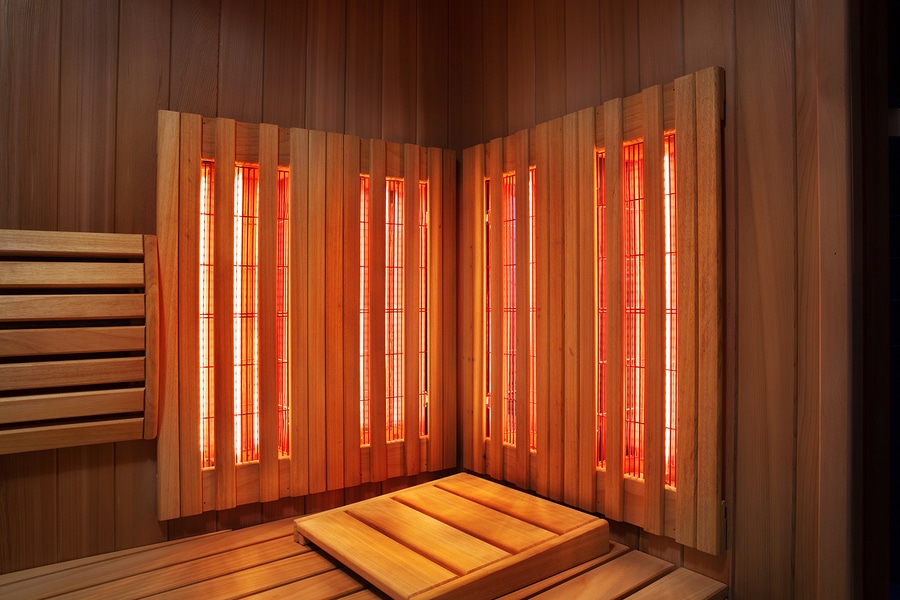Radiant, warm light from the infrared sauna impacts the body to create transformation at the cellular level, and is therefore capable of providing a cascade of health benefits beyond the scope of what many other heat therapy modalities offer.
Both the traditional sauna and the infrared sauna fall under the auspice of heat therapy and share the referenced name of ‘sauna’. However, traditional saunas and infrared saunas are very different from each other in nature by virtue of the mechanism of heat generated, and therefore, produce significantly different results on human physiology.
Ultimately, the decision to engage in any form of heat therapy stems from a desire to maximize health and wellness. Finding the appropriate sauna for you begins with familiarizing yourself with the function of each type of sauna to gain insight into the body’s response to the respective mechanism of heat generation.
Here’s a short video that explains the differences between steam and infrared saunas, and echoes why we believe infrared sauna is the better choice.
Sauna: The Etymology
Sauna is a contemporary term used to describe any heating system intended to create profuse sweating. Sauna is one of the only words in the English dictionary with its roots in the Finnish language. ‘Sauna’ (pronounced: saw-na) means bathhouse in Finnish. Many languages have borrowed the Finnish word, sauna, to describe manufactured units of controlled heat. While Finland is by no means the only country to use heat therapy, it does have a tradition that has been a landmark in their culture for thousands of years (1).
The colloquial use of the term sauna in English does not specifically refer to the heating structures that are used in Finland, but rather the general structure that intends to heat the body and produce intense sweating regardless of the methodology used to increase temperature.
Sauna has become a term used to describe a wide range of structures of controlled heat regardless of the mechanics: The fundamental function behind the creation of traditional and infrared saunas is quite different.
Understanding the type of heat generated in the traditional versus the infrared sauna unveils the distinctive health benefits that each modality offers.
The Roots of A Traditional Sauna? A Brief History

Rooted in the Finnish culture, traditional saunas evolved over thousands of years to serve as a pillar to this nation. For residents of Finland a sauna is not a luxury, but a necessity. There is on average nearly one sauna per household (There are 3 million saunas in Finland serving a population of 5 million). Most dry heat saunas found in developed countries today are based on the modern construction of the Finnish archetype.
Before the rise of the prevalence of the allopathic medical system, almost all Finnish babies were born in the sauna. There is even a sauna in the Finnish Parliament house. From birth to important political decisions, saunas are the canvas upon which the Finnish story has been painted.
The earliest known sauna structures dates back 2000 years and were dug into the earth and lined with stone. The structure of saunas in Finland has evolved substantially over thousands of years.
Sauna therapy is the cornerstone of Finnish culture. The country’s reverence for its health benefits, tradition and community support have made it among the world leaders in sauna therapy (1).
What Is A Traditional Sauna?
Traditional saunas are also referred to as dry saunas, both stemming from the Finnish culture, and are now found in spas, gyms, and hotels around the modern world. The dry sauna is heated with an electrical unit that heats the stones placed on top of it, the walls of the enclosure and the air contained within. The structures are made of wood: they feel and look like small cabins.
The temperature of these units is generally between 160 and 200 degrees Fahrenheit. To increase the temperature of the room and to add some humidity, water is poured over the heated stones.
Very often these units of heat therapy are communal but can also be built-in private homes. The traditional sauna is effective as a heat therapy modality because they are able to raise the core temperature of the human body to induce copious sweating (2).
The incredibly high temperature of these units can be uncomfortable for many people. The experience can push the threshold of its users and many will not be able to reap the full benefit of the heat therapy simply because the air temperature is extremely high.
What Is An Infrared Sauna?
In truth, it would be more apt to call an infrared sauna a ‘light bath’. The original infrared saunas constructed by Dr. Harvey Kellogg in the late nineteenth century were called ‘Incandescent Light Baths’ (3). Similar to the traditional saunas, the infrared light bath is contained by a wooden structure similar to a small cabin.
The near, mid, and far-infrared light are naturally occurring parts of the broad spectrum of light emanating from the sun. The infrared spectrum is invisible to the eye but is felt as heat.
The infrared heat emitters within the enclosure raise the temperature to anywhere from 100 to 150 degrees Fahrenheit. The nature of the wavelengths of infrared light does not actually require much increase in temperature to have a profound effect on the body.
The infrared light is able to easily penetrate into the skin membrane reaching the soft tissue of the body. The core temperature of the body is increased from the inside out and does not rely on high external temperatures to induce sweating (4).
As the infrared light seeps beyond the initial membrane of the skin to penetrate into the soft tissue of the body, the cellular mechanism of the body responds in excitement. The human form is comprised of 50 trillion cells, each cell in the body has what could be considered an ‘energy plant’: the mitochondria, where ATP (Adenosine Tri-Phosphate) occurs. The mitochondria are very sensitive to all light and particularly sensitive to deeply penetrating rays of the infrared. As soon as the body is exposed to infrared light, ATP production is exponentially stimulated (5).
Radiant Heat vs Convection Heat
Traditional saunas depend on convection heat through either electric elements or wood fuel and heat the air in the enclosed room. Exposure to the heated air warms the internal temperature of the body. The nature of convection heat requires that high temperatures be reached in order to affect the core temperature of the human body (6).
Conversely, infrared saunas rely on radiant heat. The light of the infrared emitters directly seeps into the physiological network of the body and has a streamlined effect on the molecular structure.
Radiant heat is in direct interplay with the body, while convection heat has a secondary relationship to human physiology (6).
The body responds harmoniously to the frequency of the infrared light spectrum and the cellular structures of the body are ignited by the absorption of light.
Traditional saunas heat the air temperature of the sauna. Any thermal therapy has residual health benefits on the body but they are significantly less when compared to the power of infrared light.
Practical Advantages Of The Infrared Light vs Traditional Saunas
- Shorter Heating Time
- Less Power Used
- Lower Temperatures
Infrared saunas do not depend on increased heat to be effective; they are inherently impactful because of the emitting light frequency.
The infrared sauna is less time consuming than the traditional sauna because the infrared sauna does not rely exclusively on extreme high temperatures. Traditional saunas are ineffective if there is no associated heat. It takes roughly an hour to reach optimal temperatures for a traditional sauna. This means that you will need to plan your time accordingly. Traditional saunas cannot be used spontaneously and need to reach 185-200 degrees Fahrenheit to be effective; naturally, time is required to reach these temperatures.
Conversely, infrared saunas do not need to be preheated. Exposing the body to the radiance of the infrared light has a powerful effect on the physiological network without increasing the heat. Of course, if your preference is to preheat your infrared sauna it takes about 15-20 minutes to reach the approximately 110 degrees Fahrenheit.
Health Benefits of An Infrared Sauna vs Traditional Sauna: It’s In The Light

The body’s response to the infrared spectrum boasts health benefits exclusive to this type of thermal therapy. All heat therapy, including traditional saunas, produce positive results on the body’s network, including improved circulation, cardiovascular health and prolific perspiration for detoxification.
There are some powerful transformative health benefits available only through exposure to infrared light, however. The key is in the specific way that the cellular structures within the body respond to the frequency of infrared light.
Absorbing the broad spectrum of infrared light through the skin membrane produces these exclusive health benefits (7):
- Neurogenesis (production of new brain cells)
- Increased collagen production
- Accelerated production of Human Growth Hormones (responsible for increasing muscle tone and decreasing fatty tissue.)
- Improved Insulin Sensitivity (necessary for treatment and prevention of Type I diabetes)
- Heightened ATP production (Hyper oxygenation of the blood)
- Balanced Serotonin Production (stabilized moods)
- Supports Endocrine Health (Adrenal Support)
- Faster Injury Recovery (Including the skeletal, connective tissues and muscular repair)
- Augmented Lymphatic Health
In short, exposure to the infrared light waves, even without increased heat has profoundly positive effects on the following illnesses:
Brain Degenerative diseases (8):
- Parkinson’s disease
- Amyotrophic Lateral Sclerosis (ALS)
- Alzheimer’s disease
Infrared light also aids in the prevention and recovery of illnesses created by a lack of endocrine health such as (9):
- Rheumatoid arthritis
- Fibromyalgia
- Thyroid imbalances
- Adrenal burnout
Exposure to infrared wavelengths also has profound anti-aging effects, helps to maintain an ideal weight, stabilize mood and quickens injury recovery (10).
In addition to the exclusive health benefits offered by the infrared sauna: augmented detoxification protocol exponentially increases through heavy sweating.
Cardiovascular health and improved circulation are also powerful motivating factors to choosing infrared sauna therapy over the traditional dry sauna (9).
Any health benefits available through traditional sauna therapy are also accessible through infrared sauna use: Additionally, there are a myriad of health benefits exclusive to the exposure of infrared light.
Broad Spectrum Infrared Sauna For Relaxation

The lower temperatures of the infrared sauna create a much more hospitable and enjoyable environment. Many individuals report severe discomfort sitting in the 200 degrees Fahrenheit temperatures of the traditional sauna. Rather than negotiating the overbearing temperatures of the traditional sauna, infrared heat is welcoming and enjoyable.
Relaxation not only feels good, but it is also necessary to maintain optimal health. The infrared sauna coaxes the body out of sympathetic dominance (fight or flight) into the parasympathetic (rest and relaxation) branch of the autonomic nervous system. Many chronic conditions may be stress-induced and finding a sanctuary space of rest and therefore relaxation may be necessary for optimal health.
The warm hues of the infrared light spectrum will bathe you in the natural relaxation your body craves.
A Brief Overview Of The Differences Between Infrared Saunas And Traditional Saunas
Comparing the traditional sauna with the infrared sauna is natural when you decide to embark on the journey of heat therapy. In reality, there is no comparison: They share the name ‘sauna’, but the distinct nature of the infrared radiant light significantly alters biochemistry to make this method of heat therapy exponentially more beneficial for health.
Exposure to the full infrared light spectrum opens the body up to its own healing mechanism as it dances in relation to light frequency. Warm hues of light bask the body in the relaxing environment of the infrared sauna while igniting cellular transformation to optimize your health and wellness, traditional dry saunas pale by comparison to the transformative and transcendent results produced through regular infrared sauna use.
Sources:
- https://europepmc.org/article/med/3218899
- https://www.hindawi.com/journals/ecam/2018/1857413/
- Harvey Kellogg MD, Light Therapeutics, 1910, Michigan, USA
- https://www.mayoclinic.org/healthy-lifestyle/consumer-health/expert-answers/infrared-sauna/faq-20057954
- https://www.ncbi.nlm.nih.gov/pubmed/16120414
- https://www.herschel-infrared.com/how-it-works/radiant-versus-convection-heat/
- https://www.healthline.com/health/infrared-sauna-benefits#1
- https://www.ncbi.nlm.nih.gov/pmc/articles/PMC5066074/
- https://www.ncbi.nlm.nih.gov/pmc/articles/PMC4935255/
- https://www.inbmedical.com/9-clinical-studies-that-demonstrate-the-anti-aging-benefits-of-infrared-light-therapy


